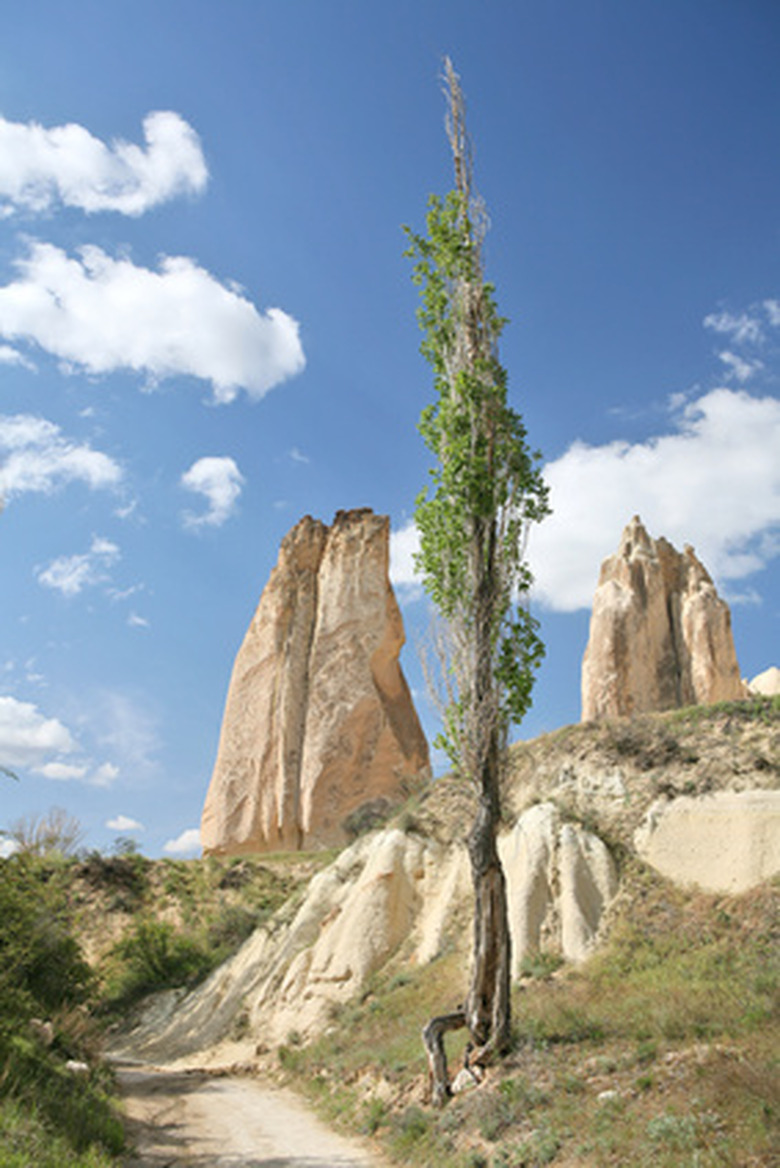Types Of Flowers In Turkey
With a hugely varied geographical landscape, Turkey is home to more than 9,000 flower species, 3,000 of which are native. Many flowers cultivated in gardens around the world originated from Turkish cultivars, and one of Turkey's major export industries is flower bulbs. Since many of these bulbs are quite rare, the Turkish government is working with international conservationists to protect the country's botanical treasures.
Tulips
Turkey is perhaps best known for its tulips, native not just to modern Turkey but the rest of the Ottoman Empire, which once encompassed mountainous regions of Central Asia and the Middle East. Tulips are a common design motif on Turkish ceramics, textiles and carpets. Even the small glass teacups used in Turkey are tulip-shaped. Bulbs exported to Europe from Ottoman gardens spawned a frenzy of market speculation in the 17th century, which led to a market crash that was felt over Europe. Tulips remain popular flowers because of how easily they break into new colors, patterns and shapes. Many wild species grow in Anatolia, and tulips are cultivated in home gardens and public landscaping projects around the country.
- With a hugely varied geographical landscape, Turkey is home to more than 9,000 flower species, 3,000 of which are native.
- Many wild species grow in Anatolia, and tulips are cultivated in home gardens and public landscaping projects around the country.
Snowdrops
Snowdrops are an intriguing flower because they can start coming up when there is still snow on the ground. Called "kardelen" in Turkish, snowdrops are native to the wet, forested mountains near the Black Sea in northern Turkey. Varieties of these delicate white flowers like Galanthus rizehensis and Galanthus ikariae once blanketed the mountains of Anatolia, but centuries of bulb hunters have nearly decimated the population. Today, conservationist groups are working with Turkish villagers to cultivate snowdrops and bolster their struggling local economies.
Cyclamen
Ten species of cyclamen can be found in Anatolia, most commonly in southwestern and southeastern Turkey. Cyclamen is another native Turkish flower that is threatened by overharvesting in the wild. Their cultivation is increasing in these regions to protect the wild specimens. One notable variety, cyclamen mirabile, is a popular garden plant around the world because of its pink and magenta autumn blooms and distinctive variegated leaves. In the 1960s, cyclamen mirabile had almost disappeared in Turkey due to overcultivation, but in the 1980s large numbers of them began appearing in European and North American gardens due to illegal harvesting and export. Turkey is working to enforce a ban on the export of wild native varieties of cyclamen.
- Snowdrops are an intriguing flower because they can start coming up when there is still snow on the ground.
- Varieties of these delicate white flowers like Galanthus rizehensis and Galanthus ikariae once blanketed the mountains of Anatolia, but centuries of bulb hunters have nearly decimated the population.
Crocus
Much of Turkey's geography is high-elevation steppes, which are rolling hills or grassy plains that support unique growing conditions. The western and central steppes of Turkey are home to as many as 35 varieties of crocus as well as daisies, poppies and violets. The blanket of wildflowers on the hilly plains in spring are the inspiration for traditional Turkish carpet and kilim designs. The parent flowers of the hybrid crocus chrysanthus originally came from Turkey. Crocus chrysanthus, also known as snow crocus, has several common varieties like cream beauty and Zwanenburg bronze, which are commonly seen in American and European gardens.
Roses
Approximately 25 percent of all species of rose are native to Turkey. Roses are endemic to the northern, eastern and northeastern regions of Turkey and are widely cultivated there today. Turkey is currently one of the world leaders in production of rose seeds and seedling shrubs, which are exported to produce hybrids. Roses in Turkey are not only raised for ornamental flowers, but also for rosehips used in teas and cold drinks. Rosa gallica and rosa damascena are both grown to make rose oil and rosewater, used in cosmetics and in flavorings for desserts. Called "gül" in Turkish, it is a popular girl's name that is used alone or in combinations like "Songül" (last rose) and "Gülbahar" (spring rose).
- Much of Turkey's geography is high-elevation steppes, which are rolling hills or grassy plains that support unique growing conditions.
- Crocus chrysanthus, also known as snow crocus, has several common varieties like cream beauty and Zwanenburg bronze, which are commonly seen in American and European gardens.
